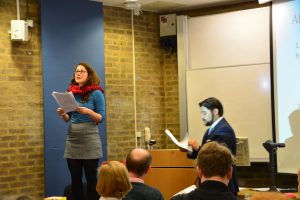A guest post by Anna Hegland
Last month I attended the first workshop for the Cultures of Performance research cluster. Having never attended a textual workshop as an audience member, I’ll admit I had no idea what to expect! So, I approached it the same way I do formal theatrical performance: with open eyes and ears, ready to take in the visual and aural aspects of the workshop texts.
I was unfamiliar with two of the three excerpted texts but this made for an interesting dynamic and I became aware of how I listen to and process performances. During the first two pieces, I listened more closely for words or ideas that could give me a clue as to the genre and intent of the piece. As I tried to figure out what kind of person would have written these texts (courtier, playwright, vicar, etc) based on content and style, I picked up on phrasings that sounded familiar… though this may have been in an effort to place new texts in a recognizable context. On the other hand, during Chaucer’s Miller’s Tale, which I had read but never seen performed, I watched the actors more closely than I had before. I still listened to the text, but because it was a text with which I was already familiar, I was more tuned in to the physical ways in which the actors interpreted the text for us.

Francisca Stangel and Jon-Mark Grussenmeyer performing Anthony Munday’s A Breefe and True Reporte, of the Execution of Certaine Traytours at Tiborne (1582).
I was surprised by how easily I followed the two (to me) new texts — a credit to the actors. I especially appreciated seeing a text performed in several different ways. John Northbrooke’s A Treatise Against Dicing, Dancing, Plays, and Interludes, with Other Idle Pastimes was one such text. When it was first acted out for us, I was struck by how funny it was. It didn’t look or sound at all like the kind of didactic, moralizing text that the words indicated it should be. Northbrooke’s characters were meant to warn the reader of the dangers of idle pastimes, but their first performance made the London inns and early playhouses sound very exciting. On their second read however, the tone was sober and ministerial. Such a pronounced contrast completely changed the piece, which in turn changed the posture and gestures of the actors, and the audience’s responses.
All three texts lent themselves to performance well. Even in non-theatrical, prose texts, there were identifiable aspects of performance, whether as a narrative voice that set the scene and directed the audience’s gaze, or the declamatory style that was a holdover from medieval sermons. I found the workshop really illuminating, since it got me to reflect on the nature of performance within medieval and early modern texts more widely, and I’m already looking forward to exploring more texts at the next workshop.